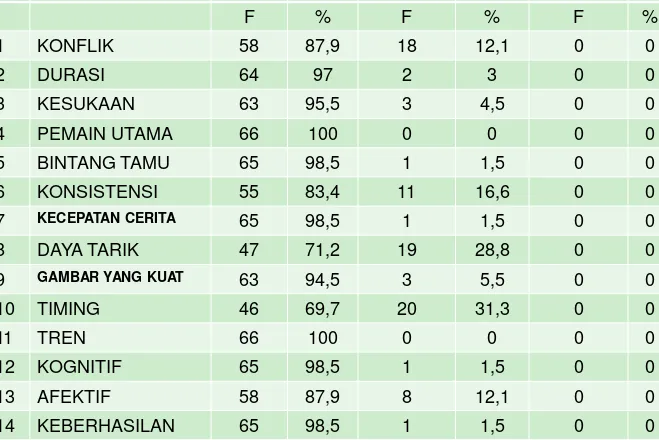McGraw-Hill/Irwin Copyright © 2010 by The McGraw-Hill Companies, Inc. All rights reserved.
Dot Plots
Mengelompokkan data sesederhana
mungkin
identitas data secara
individual tetap ada
Data ditampilkan dalam bentuk titik
sepanjang garis horisontal sesuai
nilainya
4-3
Dot Plots - Contoh
Distribusi Frekuensi
Distribusi Frekuensi diguanakan untuk
mengorganisasikan data ke dalam bentuk
yang memiliki arti
Keuntungan Distribusi Frekuensi: gambaran
visual tentang bentuk penyebaran data
Kerugian Distribusi Frekuensi:
(1)
Hilangnya identitas asli setiap nilai
(2)
Sulit melihat penyebaran nilai tiap kelas
4-5
Stem-and-Leaf
Tiap nilai dibagi dua. Digit utama menjadi
STEM dan digit sisanya menjadi LEAF. Stem
dituliskan secara vertikal, Leaf dituliskan
secara horisontal
4-7
Cara alternatif (selain standar deviasi) untuk
menggambarkan penyebaran data adalah
dengan menentukan LOKASI NILAI yang
membagi data menjadi beberapa bagian yang
setara
QUARTILES =
KUARTIL
(DIBAGI 4)
DECILES =
DESIL
(DIBAGI 10)
PERCENTILES =
PERSENTIL
( DIBAGI 100)
4-9
L
p=
persentil yang dicari (misalnya Persentil 33
L
33) n =
jumlah data
Median =
L
50
Syarat: Median
data diurutkan
Percentiles - Example
Listed below are the commissions earned
last month by a sample of 15 brokers at
Salomon Smith Barney’s Oakland,
California, office.
$2,038 $1,758 $1,721 $1,637 $2,097 $2,047 $2,205 $1,787 $2,287 $1,940 $2,311 $2,054 $2,406 $1,471 $1,460
4-11
Percentiles
–
Example (cont.)
Step 1: Organize the data from lowest to
largest value
$1,460
$1,471
$1,637
$1,721
$1,758
$1,787
$1,940
$2,038
$2,047
$2,054
$2,097
$2,205
Percentiles
–
Example (cont.)
4-13
Boxplot Example
Step1: Create an appropriate scale along the horizontal axis.
Step 2: Draw a box that starts at Q1 (15 minutes) and ends at Q3 (22
minutes). Inside the box we place a vertical line to represent the median (18 minutes).
4-15
Skewness
In Chapter 3, measures of central location (the
mean, median, and mode) for a set of observations
and measures of data dispersion (e.g. range and the
standard deviation) were introduced
Another characteristic of a set of data is the shape.
There are four shapes commonly observed:
–
symmetric,
–
positively skewed,
–
negatively skewed,
4-17
Skewness - Formulas for Computing
Koefisien skewness berkisar antara -3 sampai 3.
–
Nilai berkisar -3
skewness negatif
–
Nilai 1.63
skewness cukup positif
Skewness
–
An Example
Following are the earnings per share for a sample of
15 software companies for the year 2007. The
earnings per share are arranged from smallest to
largest.
Compute the mean, median, and standard deviation.
Find the coefficient of skewness using Pearson’s
estimate.
4-19
Skewness
–
An Example Using
Pearson’s Coefficient
4-21
Describing Relationship between Two
Variables
When we study the relationship
between two variables we refer to the
data as bivariate.
One graphical technique we use to
show the relationship between
variables is called a scatter diagram.
Describing Relationship between Two
4-23
In Chapter 2 we presented data from AutoUSA. In this case the information concerned the prices of 80 vehicles sold last month at the Whitner Autoplex lot in
Raytown, Missouri. The data shown include the selling price of the vehicle as well as the age of the purchaser.
Is there a relationship between the selling price of a vehicle and the age of the purchaser?
Would it be reasonable to conclude that the more expensive vehicles are purchased by older buyers?
Describing Relationship between Two
Describing Relationship between Two
4-25
Contingency Tables
A scatter diagram requires that both of the
variables be at least
interval scale
.
What if we wish to study the relationship
between two variables when one or both are
Contingency Tables
A contingency table is a cross-tabulation that
simultaneously summarizes two variables of interest.
Examples:
1.
Students at a university are classified by gender and class rank.
2.A product is classified as acceptable or unacceptable and by the
shift (day, afternoon, or night) on which it is manufactured.
3.
A voter in a school bond referendum is classified as to party
4-27
Contingency Tables
–
An Example
A manufacturer of preassembled windows produced 50 windows yesterday. This morning the quality assurance inspector reviewed each window for all quality aspects. Each was classified as acceptable or unacceptable and by the shift on which it was produced. Thus we reported two variables on a single item. The two variables are shift and quality. The results are reported in the following table.
Using the contingency table able, the quality of the three shifts can be compared. For example:
1. On the day shift, 3 out of 20 windows or 15 percent are defective. 2. On the afternoon shift, 2 of 15 or 13 percent are defective and 3. On the night shift 1 out of 15 or 7 percent are defective.
URAIAN TINGGI SEDANG RENDAH
F % F % F %
1 KONFLIK 58 87,9 18 12,1 0 0
2 DURASI 64 97 2 3 0 0
3 KESUKAAN 63 95,5 3 4,5 0 0
4 PEMAIN UTAMA 66 100 0 0 0 0
5 BINTANG TAMU 65 98,5 1 1,5 0 0
6 KONSISTENSI 55 83,4 11 16,6 0 0
7 KECEPATAN CERITA 65 98,5 1 1,5 0 0
8 DAYA TARIK 47 71,2 19 28,8 0 0
9 GAMBAR YANG KUAT 63 94,5 3 5,5 0 0
10 TIMING 46 69,7 20 31,3 0 0
11 TREN 66 100 0 0 0 0
12 KOGNITIF 65 98,5 1 1,5 0 0
4-29
DATA
KARAKTERISTIK RESPONDEN
VARIABEL KATEGORI JUMLAH PERSEN
JENIS KELAMIN PRIA 31 47
WANITA 35 53
USIA 12 - 19 3 4,5
20-29 18 27,3
30-39 20 30,3
40-49 15 22,7
50-59 9 13,6
>60 1 1,5
PEKERJAAN PNS 8 12,1
KARYAWAN 18 27,3
IRT 21 31,8
PELAJAR 6 9,1
WIRASWASTA 4 6,1
PEDAGANG 2 3
BURUH 3 4,5
